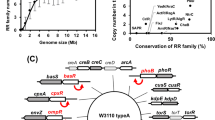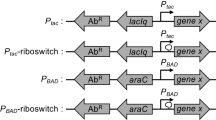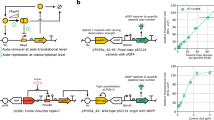Abstract
The design of biological containment systems to be employed in a broad spectrum of bacteria useful in industrial fermentations and in connection with release to the environment is reported. The key element is a gene, hok, encoding a small polypeptide of 52 amino acids that is lethal when expressed in a variety of bacterial species. Constructing combinations of regulatable promoters and this toxin gene has allowed us to design model systems that in simple ways ensure cell survival under controlled conditions (the fermenter), whereas any cells accidentally escaping to the environment, or any other new combination of a bacterium and the toxin-carrying plasmid, will be killed. A specific application of the containment system with respect to deliberate release is based on a fusion between an invertible promoter and the toxin gene. This results in a stochastic induction of the killing function, which will lead to the elimination of the organism as a consequence of competition with related bacteria in the environment.
This is a preview of subscription content, access via your institution
Access options
Subscribe to this journal
Receive 12 print issues and online access
$209.00 per year
only $17.42 per issue
Buy this article
- Purchase on Springer Link
- Instant access to full article PDF
Prices may be subject to local taxes which are calculated during checkout
Similar content being viewed by others
References
Federal register, Department of Health and Human Services. Part III: Guidelines for research involving recombinant DNA molecules. National Institutes of Health 1986, 16957–16985.
Curtiss, R., III, M., Inouye, Pereira, D., Hsu, J.C., Alexander, L. and Rock, L. 1977. Construction in use of safer bacterial host strains for recombinant DNA research, p. 248–269. In: Molecular cloning of recombinant DNA. Scott, W. A., and Werner, R. (Eds.). Academic Press, New York.
Slater, J.H. 1985. Gene transfer in microbial communities, p. 89–98. In: Engineered organisms in the environment: Scientific issues. Hal-vorson, H., Pramer, D., Rogul (Eds.). ASM, Washington, D.C.
Shapiro, J.A. 1985. Intercellular communication and genetic change in bacterial populations, p. 63–69. In: Engineered organisms in the environment: Scientific issues. Halvorson, H., Pramer, D., Rogul (Eds.). ASM, Washington, D.C.
Gerdes, K., Rasmussen, P.B. and Molin, S. 1986. Unique type of plasmid maintenance function: Postsegregational killing of plasmid-free cells. Proc. Natl. Acad. Sci. USA 83: 3116–3120.
Gerdes, K., Bech, F.W., Jorgensen, S.T., Lobner-Olesen, A., Rasmus-sen, P.B., Atlung, T., Karlstrom, O., Molin, S. and von Meyenburg, K. 1986. Mechanism of postsegregational killing by the hok gene product of the parE system of plasmid R1 and its homology with the relF gene product of the E. coli relB operon. EMBO J. 5: 2023–2029.
Rose, J.K. and Yanofsky, C. 1974. Interaction of the operator of the tryptophan operon with represser. Proc. Natl. Acad. Sci. USA 71: 3134–3138.
Yansura, D.G. and Henner, D.J. 1984. Use of the Escherichia coli lac represser and operator to control gene expression in Bacillus subtilis. Proc. Natl. Acad. Sci. USA 81: 439–443.
Abraham, J.M., Freitag, C.S., Clements, J.R. and Eisenstein, B.I. 1985. An invertible element of DNA controls phase variation of type 1 fimbriae of Escherichia coli. Proc. Natl. Acad. Sci. USA 82: 5724–5727.
Klemm, P. 1986. Two regulatory fim genes, fimB and fimE, control the phase variation of type 1 fimbriae in Escherichia coli. EMBO J. 6: 1389–1393.
Casadaban, M. and Cohen, S.N. 1980. Analysis of gene control signals by DNA fusion and cloning in Escherichia coli. J. Mol. Biol. 138: 179–207.
Boyer, H.W. and Roulland-Dussoix, D. 1969. A complementation analysis of the restriction and modification of DNA in Escherichia coli. J. Mol. Biol. 41: 459–472.
Dubnau, D. and Cirigliano, C. 1974. Genetic characterization of recombination-deficient mutants of Bacillus subtilis J. Bacteriol. 117: 488–493.
Simon, R., Priefer, U. and Pühler, A. 1983. A broad host range mobilization system for in vivo genetic engineering: Transposon mutagenesis in gram negative bacteria. Bio/Technology 1: 784–790.
Grindsted, J., Saunders, J.R., Ingram, L.C., Sykes, R.B. and Richmond, M.H. 1972. Properties of an R-factor which originated in Pseudomonas aeruginosa 1822. J. Bacteriol. 110: 529–537.
Bertani, G. 1951. Studies on lysogenesis. I. The mode of phage liberation by lysogenic Escherichia coli. J. Bacteriol. 62: 293–300.
Clark, J.D. and Maaloe, O. 1967. DNA replication and the division cycle in Escherichia coli. J. Mol. Biol. 23: 99–112.
Maniatis, T., Fritsch, E.F. and Sambrook, J. 1982. Molecular Cloning, a Laboratory Manual. Cold Spring Harbor Laboratory.
Sadaie, Y. and Kada, T. 1983. Formation of competent Bacillus subtilis cells. J. Bacteriol. 153: 813–821.
Promega Notes. 1986. No. 5, p. 1–4. Promega Biotec, Madison USA.
Skogman, G., Nilsson, J. and Gustafsson, P. 1983. The use of a partition locus to increase stability of tryptophan-operon-bearing plasmids in Escherichia coli. Gene 23: 105–115.
Author information
Authors and Affiliations
Rights and permissions
About this article
Cite this article
Molin, S., Klemm, P., Poulsen, L. et al. Conditional Suicide System for Containment of Bacteria and Plasmids. Nat Biotechnol 5, 1315–1318 (1987). https://doi.org/10.1038/nbt1287-1315
Received:
Accepted:
Issue Date:
DOI: https://doi.org/10.1038/nbt1287-1315
This article is cited by
-
A robust yeast biocontainment system with two-layered regulation switch dependent on unnatural amino acid
Nature Communications (2023)
-
Genetic Biocontainment Systems for the Safe Use of Engineered Microorganisms
Biotechnology and Bioprocess Engineering (2020)
-
Bioremediation: an emerging effective approach towards environment restoration
Environmental Sustainability (2020)
-
Auxotrophy to Xeno-DNA: an exploration of combinatorial mechanisms for a high-fidelity biosafety system for synthetic biology applications
Journal of Biological Engineering (2018)
-
Next-generation biocontainment systems for engineered organisms
Nature Chemical Biology (2018)



